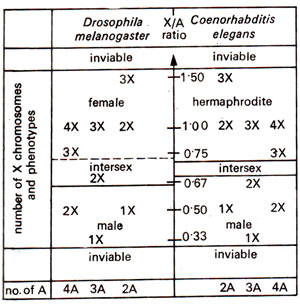X/A ratio in Coenorhabditis elegans (a free living nematode)

Fig. 17.7. Effect of X/A ratio on sex; different X/A ratios were obtained experimentally by varying the number of X chromosomes (2X, 3X, 4X) and the sets of autosomes (2A, 3A, 4A); at ratios too low (< 0.3) or too high (> 1.5) the dosage compensation is unable to prevent death; the threshold range (over which intersex develops) is slightly different in two species i.e. at X/A ratio 0.67, Drosophila is intersex, while C. elegans is male (modified from Hodgkin, 1990).

Fig. 17.7. Effect of X/A ratio on sex; different X/A ratios were obtained experimentally by varying the number of X chromosomes (2X, 3X, 4X) and the sets of autosomes (2A, 3A, 4A); at ratios too low (< 0.3) or too high (> 1.5) the dosage compensation is unable to prevent death; the threshold range (over which intersex develops) is slightly different in two species i.e. at X/A ratio 0.67, Drosophila is intersex, while C. elegans is male (modified from Hodgkin, 1990).




